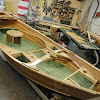Beginner's Guide to Stitch-and-Glue Boat Building
Building your own boat is a rewarding experience, offering a unique blend of craftsmanship, problem-solving, and the satisfaction of creating something truly special. Stitch-and-glue boatbuilding, a popular method for amateurs, simplifies the process significantly, making it accessible to beginners. This guide provides a comprehensive overview, empowering you to embark on your own boatbuilding adventure.
Understanding Stitch-and-Glue
Stitch-and-glue involves assembling a boat's hull from pre-cut plywood or foam-cored panels. First, you stitch the panels together using wire or string, creating the boat's shape. Then, you glue the seams, reinforcing them with fiberglass cloth and epoxy resin. This method eliminates the need for complex woodworking skills, like planking, making it ideal for first-time builders. The resulting hull is incredibly strong and lightweight, offering a fantastic balance of performance and durability.
Choosing Your Plans
Selecting the right boat plans is crucial. Beginners should opt for simpler designs with fewer curves and complex shapes. Many reputable sources offer stitch-and-glue plans for various boat types, ranging from kayaks and canoes to small sailboats and motorboats. Consider your experience level, available space, and the type of boating you plan to do when making your selection. Look for plans that include detailed instructions, diagrams, and material lists. Don't hesitate to ask questions from experienced boat builders or the plan provider if you encounter any uncertainties.
Gathering Your Tools and Materials
Before you begin, gather all necessary tools and materials. This ensures a smooth and efficient building process. Poor planning can lead to frustrating delays. Your list should include:
- Plywood or foam-cored panels: Choose marine-grade plywood or foam-cored panels for superior durability and water resistance.
- Epoxy resin and hardener: Epoxy is the glue that holds your boat together. Follow the manufacturer's instructions carefully for mixing ratios.
- Fiberglass cloth: Use fiberglass cloth to reinforce the glued seams, adding strength and water resistance to the hull.
- Stitching wire or string: This temporarily holds the panels together before gluing.
- Clamps: Numerous clamps will hold the panels firmly in place while the glue cures.
- Safety glasses and gloves: Always prioritize safety when working with epoxy and other potentially hazardous materials.
- Measuring tools: Accurate measurements are critical for a well-built boat. Invest in a quality tape measure, square, and ruler.
- Drill and drill bits: You'll need these to pre-drill holes for stitching and fastenings.
- Sandpaper and sanding block: Used for smoothing surfaces and preparing them for fiberglassing.
- Putty knife and caulking gun: These are used for applying epoxy and filling gaps.
The Stitch-and-Glue Process: Step-by-Step
The actual building process begins with meticulously laying out the panels according to your plans. Precise placement is paramount. Once you've confirmed the arrangement, begin stitching the panels together using your chosen wire or string, ensuring consistent spacing and tension. After stitching, liberally apply epoxy resin to the seams, working methodically to ensure complete saturation of the joint. Then, carefully lay fiberglass cloth over the seams, embedding it firmly into the epoxy. Use clamps to maintain pressure and ensure proper bonding. Allow the epoxy to cure completely according to the manufacturer's instructions. Once cured, you can remove the stitching and begin the finishing process.
Finishing Touches
After the glue cures, sand the seams smooth. Fill any gaps or imperfections with epoxy filler. Sand the entire hull to create a smooth surface, ready for painting or varnishing. Apply a suitable sealant to protect the wood from water damage. Finally, add any remaining components such as decks, seats, and fittings.
Enjoying Your Handmade Boat
With careful planning, meticulous attention to detail, and a healthy dose of patience, you can successfully build your own stitch-and-glue boat. Remember to consult your plans frequently and don't be afraid to seek advice from experienced boat builders. The journey itself is as rewarding as the final product – the joy of gliding across the water in a boat you built yourself is an unparalleled experience.













Tidak ada komentar:
Posting Komentar